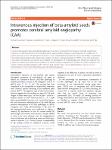Intravenous injection of beta-amyloid seeds promotes cerebral amyloid angiopathy (CAA)
Burwinkel, Michael
Lutzenberger, Manuel
Heppner, Frank L.
Schulz-Schaeffer, Walter
Baier, Michael
Seeding and spread of beta-amyloid (Aβ) pathologies have been considered to be based on prion-like mechanisms. However, limited transmissibility of Aβ seeding activity upon peripheral exposure would represent a key difference to prions, not only in terms of pathogenesis but also in terms of potential transmission of disease. We partially characterized the seeded Aβ amyloidosis after intracerebral injection of various brain homogenates in APP/PS1 mice. One particularly seed-laden homogenate was selected to investigate the development of Aβ pathologies after intravenous exposure. We report here that a single intravenous injection of an Alzheimer disease patient’s-brain extract into APP/PS1 recipient mice led to cerebral amyloid angiopathy within 180 days post injection. Thus, vascular proteinopathies such as CAA are transmissible in mice via the intravenous route of peripheral exposure.
No license information

